Despite declining trusts in some news brands in India — especially as alternative sources like social media being available and patronised — some of the legacy platforms such as NDTV, Times of India, Republic TV and BBC News continue to enjoy high viewership among younger, urban and mostly English-speaking people who were surveyed, Reuters Digital News Report 2024 stated.
Interestingly, both the Indian public broadcasters — Doordarshan News and All India Radio — were trusted by a high percentage (64 and 65 percent, respectively) of the people who were part of the sample. (https://reutersinstitute.politics.ox.ac.uk/digital-news-report/2024/india)
The research associate for the India chapter of this global study, carried out by the Reuters Institute for the Study of Journalism, observed that survey respondents “reflect, in some measure, a new generation of Indians whose main source of news is often via social media platforms”.
Commenting on the trustworthiness of DD News and Akashvani news, former CEO of Prasar Bharati (the parent of DD and AIR), Shashi Shekhar Vempati, yesterday said on X: “Good to see that the Public Broadcasters @airnewsalerts and @DDNewslive continue to enjoy the Highest levels of Trust as Sources of News in India despite all of the Disinformation and Propaganda regarding Freedom of Speech in India. @prasarbharati @MIB_India.”
Coming back to the global reports finding, almost half of the Indian respondents use YouTube (54 percent) and WhatsApp (48 percent) for news each week, while Facebook and X are becoming less popular.
“However, legacy platforms such as NDTV, Times of India, Republic TV, and BBC News continue to enjoy high viewership in their offline and online products, among our younger, urban, mostly English-speaking sample.
“Despite a general decline in interest in news over the years, print (40 percent) and TV (46 percent) remain popular platforms for respondents to access news, especially during this crucial election year,” the Reuters survey noted on the Indian trends.
Highlighting the takeover of NDTV by AMG Media Networks, which is part of the powerful business conglomerate Adani Enterprises Ltd., which has increased its stake in the news agency Indo-Asian News Service (IANS) and more recently in the company that runs the digital financial news platform BQ Prime, the survey findings stated that such developments point towards heavy forays of corporates in the Indian media.
“The Adani Group’s expansion within the media landscape reflects the increasing corporatisation of media in India,” the Digital News Report said.
As a disclaimer, the researchers have noted that the data on Indian media were based on a survey of mainly English-speaking, online news users in India — a small subset of a larger, more diverse, media market. Findings in this online poll are not nationally representative and will tend to under-represent the continued importance of traditional media such as TV and print.
Meanwhile, global concerns about the use of AI in news production and misinformation are growing, the report published by the Reuters Institute for the Study of Journalism found, posing fresh challenges to newsrooms already struggling to engage audiences, Reuters reported yesterday.
The institute’s annual Digital News Report published on Monday, which this year is based on surveys of nearly 100,000 people across 47 countries, offers a picture of the hurdles news media faces in lifting revenue and sustaining business.

Here is a summary of some of the key findings from the 2024 research:
# In many countries, especially outside Europe and the United States, we find a significant further decline in the use of Facebook for news and a growing reliance on a range of alternatives including private messaging apps and video networks. Facebook news consumption is down 4 percentage points, across all countries, in the last year.
# News use across online platforms is fragmenting, with six networks now reaching at least 10 percent of our respondents, compared with just two a decade ago. YouTube is used for news by almost a third (31 percent) of our global sample each week, WhatsApp by around a fifth (21 percent), while TikTok (13 p
ercent) has overtaken Twitter (10 percent), now rebranded X, for the first time.
# Linked to these shifts, video is becoming a more important source of online news, especially with younger groups. Short news videos are accessed by two-thirds (66 percent) of our sample each week, with longer formats attracting around half (51 percent). The main locus of news video consumption is online platforms (72 percent) rather than publisher websites (22 percent), increasing the challenges around monetisation and connection.
# Although the platform mix is shifting, the majority continue to identify platforms including social media, search, or aggregators as their main gateway to online news. Across markets, only around a fifth of respondents (22 percent) identify news websites or apps as their main source of online news – that’s down 10 percentage points on 2018.
# Publishers in a few Northern European markets have managed to buck this trend, but younger groups everywhere are showing a weaker connection with news brands than they did in the past.
# Turning to the sources that people pay most attention to when it comes to news on various platforms, we find an increasing focus on partisan commentators, influencers, and young news creators, especially on YouTube and TikTok. But in social networks such as Facebook and X, traditional news brands and journalists still tend to play a prominent role.
# Concern about what is real and what is fake on the internet when it comes to online news has risen by 3 percentage points in the last year with around six in ten (59 percent) saying they are concerned. The figure is considerably higher in South Africa (81 percent) and the United States (72 percent), both countries that have been holding elections this year.
# Worries about how to distinguish between trustworthy and untrustworthy content in online platforms is
highest for TikTok and X when compared with other online networks. Both platforms have hosted misinformation or conspiracies around stories such as the war in Gaza, and the Princess of Wales’s health, as well as so-called ‘deep fake’ pictures and videos.
# As publishers embrace the use of AI we find widespread suspicion about how it might be used, especially for ‘hard’ news stories such as politics or war. There is more comfort with the use of AI in behind-the-scenes tasks such as transcription and translation; in supporting rather than replacing journalists.
# Trust in the news (40 percent) has remained stable over the last year, but is still four points lower overall than it was at the height of the Coronavirus pandemic. Finland remains the country with the highest levels of overall trust (69 percent), while Greece (23 percent) and Hungary (23 percent) have the lowest levels, amid c
oncerns about undue political and business influence over the media.
# Elections have increased interest in the news in a few countries, including the United States (+3), but the overall trend remains downward. Interest in news in Argentina, for example, has fallen from 77 percent in 2017 to 45 percent today. In the United Kingdom interest in news has almost halved since 2015. In both countries the change is mirrored by a similar decline in interest in politics.

# At the same time, we find a rise in selective news avoidance. Around four in ten (39 percent) now say they sometimes or often avoid the news – up 3 percentage points on last year’s average – with more significant increases in Brazil, Spain, Germany, and Finland. Open comments suggest that the intractable conflicts in Ukraine and the Middle East may have had some impact. In a separate question, we find that the proportion that say they feel ‘overloaded’ by the amount of news these days has grown substantially (+
11pp) since 2019 when we last asked this question.
# In exploring user needs around news, our data suggest that publishers may be focusing too much on updating people on top news stories and not spending enough time providing different perspectives on issues or reporting stories that can provide a basis for occasional optimism. In terms of topics, we find that audiences feel mostly well served by political and sports news but there are gaps around local news in some countries, as well as health and education news.
# Our data show little growth in news subscriptions, with just 17 percent saying they paid for any online news in the last year, across a basket of 20 richer countries. North European countries such as Norway (40 percent) and Sweden (31 percent) have the highest proportion of those paying, with Japan (9 percent) and the United Kingdom (8 percent) amongst the lowest.
# As in previous years, we find that a large proportion of digital subscriptions go to just a few u
pmarket national brands – reinforcing the winner-takes-most dynamics that are often linked with digital media. In some countries we find evidence of heavy discounting, with around four in ten (41 percent) saying they currently pay less than the full price. Prospects of attracting new subscribers remain limited by a continued reluctance to pay for news, linked to low interest and an abundance of free sources.
# Well over half (55 percent) of those that are not currently subscribing say that they would pay nothing for online news, with most of the rest prepared to offer the equivalent of just a few dollars per month, when pressed. Across markets, just 2 percent of non-payers say that they would pay the equivalent of an average full price subscription.
# News podcasting remains a bright spot for publishers, attracting younger, well-educated audiences but is a minority activity overall. Across a basket of 20 countries, just over a third (35 percent) access a podcast monthly, with 13 percent accessing a show relating to news and current affairs. Many of the most popular podcasts are now filmed and distributed via video platforms such as YouTube and TikTok.
The full version of the Reuters Digital News Report could be accessed at:https://reutersinstitute.politics.ox.ac.uk/digital-news-report/2024 .
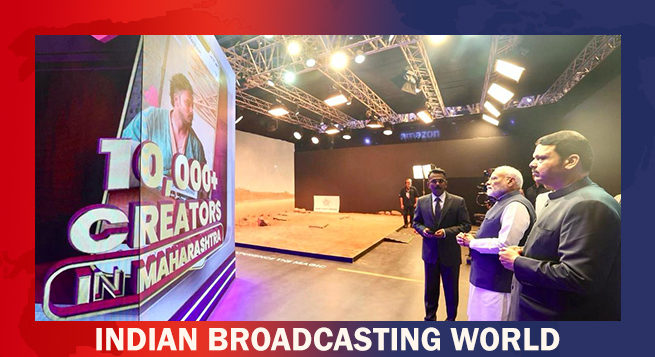 MIB to unveil M&E sector statistical handbook today at WAVES
MIB to unveil M&E sector statistical handbook today at WAVES  WAVES 2025: Media dialogue backs creativity, heritage & ethics in AI Era
WAVES 2025: Media dialogue backs creativity, heritage & ethics in AI Era  Pay TV leaders chart course for India’s linear TV in digital age
Pay TV leaders chart course for India’s linear TV in digital age 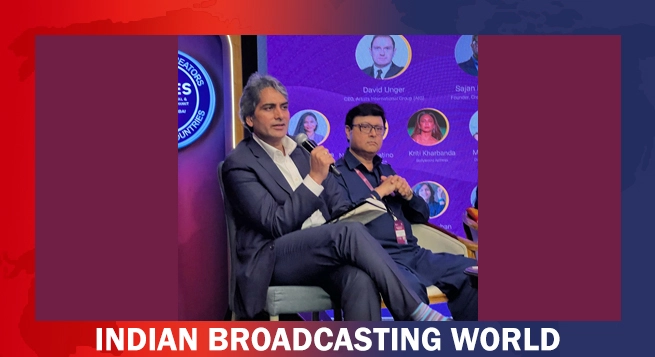 Sudhir Chaudhary announces new show for DD News, says “Good content still has a place” at WAVES 2025
Sudhir Chaudhary announces new show for DD News, says “Good content still has a place” at WAVES 2025 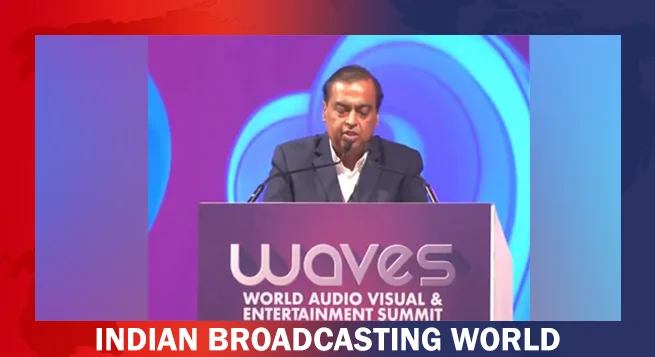 India can lead global entertainment revolution: Mukesh Ambani
India can lead global entertainment revolution: Mukesh Ambani  TRAI chief not in favour of separate rules for OTT, legacy b’casters
TRAI chief not in favour of separate rules for OTT, legacy b’casters 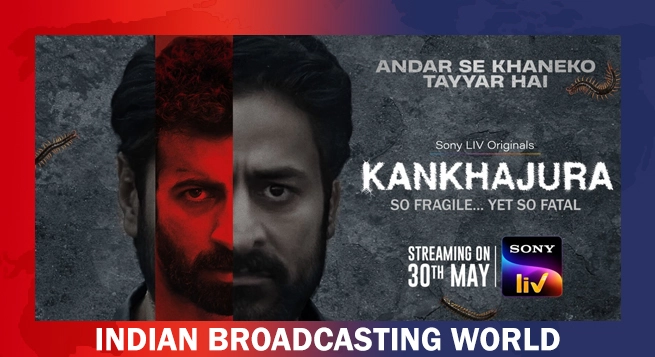 ‘KanKhajura’ start streaming on Sony LIV from May 30
‘KanKhajura’ start streaming on Sony LIV from May 30  Koyal.AI debuts at WAVES 2025, set to revolutionise music videos with GenAI
Koyal.AI debuts at WAVES 2025, set to revolutionise music videos with GenAI 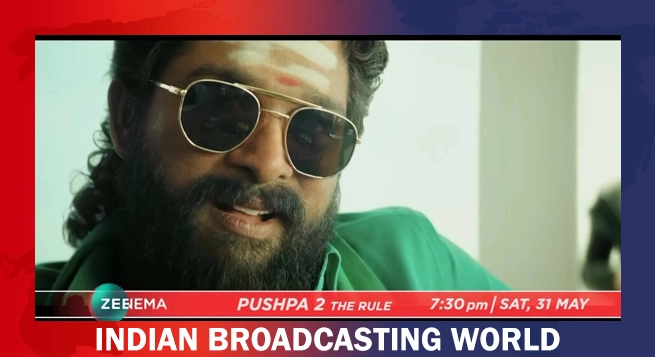 Zee Cinema to premiere ‘Pushpa 2: The Rule’ on May 31
Zee Cinema to premiere ‘Pushpa 2: The Rule’ on May 31  ‘Create in India Challenge’ S1 honours global talent at WAVES
‘Create in India Challenge’ S1 honours global talent at WAVES  Amazon MX Player adds 20+ dubbed international titles
Amazon MX Player adds 20+ dubbed international titles 








